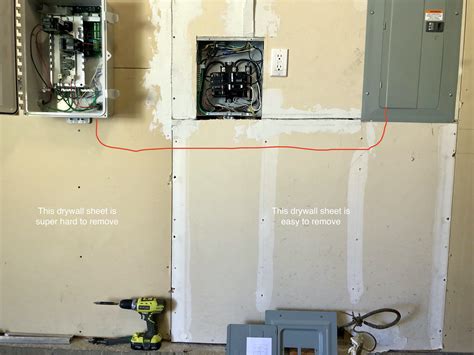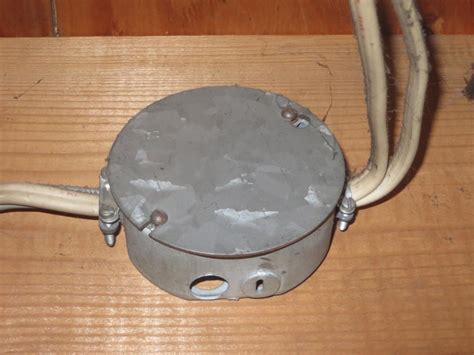can a junction box go outside a wall Yes, it's done all the time for outside lights, receptacles, etc. As long as the Romex lands in a box attached to the building. You can't have Romex outdoors, even in conduit. But is allowed to terminate directly into a box. Our wholesale metal tins are available in tin-plated steel and come in a variety of shapes, including round, oblong, rectangular, and square tins with lids. Capacities range from less than 0.5 ounces or 10 milliliters to as large as 6 gallons or 25 liters.
0 · transition from inside wall to outside
1 · running romex into junction box
Get wholesale prices on electrical boxes, whether it's an outlet box, junction box, single gang or 2 gang, when you shop Elliott Electric Supply. From arrestors to electrical boxes and wiring devices, we've got your electrical needs covered.
Yes, it is generally permissible to install a junction box on an exterior wall as long as it meets certain code requirements. The main considerations are that the box must be weatherproof, properly secured, and .

You must start and end the conduit run in a junction box (or panel), but at that junction box you can transition to another wiring method. For instance, you might bring Romex to the junction box, then run THWN wires outdoors . Yes, it's done all the time for outside lights, receptacles, etc. As long as the Romex lands in a box attached to the building. You can't have Romex outdoors, even in conduit. But is allowed to terminate directly into a box.
I would run the cable out through the short end of an LB, then down into a weatherproof junction box, and take off from there to your conduit with THHN. IF you can access the wiring on the inside, then the junction box .
The box should be mounted securely to a stud or joist, with its face flush to the wall surface. For exterior installations, select a location that provides protection from direct exposure to the elements. Option One: If you have an unfinished basement, you can tap into a junction box in the basement and run the cable out through the rim joist. This is even easier than tapping into a main floor outlet. Plus it allows you to put your . Considering the NEC guidelines, it is generally not recommended to place a junction box inside a wall. This is primarily because accessibility can be compromised if the .
Junction boxes protect electrical wires from damage, prevent shocks, and stop sparks from igniting flammable material nearby. To install one, you’ll need to strip the ends off all the wires that will be in the box. To . You can’t conceal junction boxes in ceilings, walls or non-accessible attics and under-floor areas. In addition, they should not be placed in areas where flammable gases, vapors or dust are present in an amount that could result in . But I think I can run NM-B to a junction box in the crawlspace directly behind that wall, and run a few feet of UF-B through a 1/2" or 5/8" hole in the mortar, seal the hole with .
Yes, it is generally permissible to install a junction box on an exterior wall as long as it meets certain code requirements. The main considerations are that the box must be weatherproof, properly secured, and easily accessible. You must start and end the conduit run in a junction box (or panel), but at that junction box you can transition to another wiring method. For instance, you might bring Romex to the junction box, then run THWN wires outdoors through the "conduit as a wiring method" then transition back to Romex in the other building's junction box. Yes, it's done all the time for outside lights, receptacles, etc. As long as the Romex lands in a box attached to the building. You can't have Romex outdoors, even in conduit. But is allowed to terminate directly into a box. I would run the cable out through the short end of an LB, then down into a weatherproof junction box, and take off from there to your conduit with THHN. IF you can access the wiring on the inside, then the junction box would be .
The box should be mounted securely to a stud or joist, with its face flush to the wall surface. For exterior installations, select a location that provides protection from direct exposure to the elements. Option One: If you have an unfinished basement, you can tap into a junction box in the basement and run the cable out through the rim joist. This is even easier than tapping into a main floor outlet. Plus it allows you to put your new outlet anywhere, not .
transition from inside wall to outside
Considering the NEC guidelines, it is generally not recommended to place a junction box inside a wall. This is primarily because accessibility can be compromised if the junction box is hidden within the wall cavity.It has to go outside, thus drilling a hole big enough for the clamp in the backing. The cable will run straight through the wall from the inside of the garage. It has to be clamped (and protected by the clamp) where it enters the box, and according to the rules inside the garage, which means appropriate nail plates where it runs through studs . Junction boxes protect electrical wires from damage, prevent shocks, and stop sparks from igniting flammable material nearby. To install one, you’ll need to strip the ends off all the wires that will be in the box. To complete the electrical circuit, tie together the same-colored wires and hold them in place with wire nuts. You can’t conceal junction boxes in ceilings, walls or non-accessible attics and under-floor areas. In addition, they should not be placed in areas where flammable gases, vapors or dust are present in an amount that could result in a fire or explosion.
sheet metal server chassis
Yes, it is generally permissible to install a junction box on an exterior wall as long as it meets certain code requirements. The main considerations are that the box must be weatherproof, properly secured, and easily accessible. You must start and end the conduit run in a junction box (or panel), but at that junction box you can transition to another wiring method. For instance, you might bring Romex to the junction box, then run THWN wires outdoors through the "conduit as a wiring method" then transition back to Romex in the other building's junction box.
Yes, it's done all the time for outside lights, receptacles, etc. As long as the Romex lands in a box attached to the building. You can't have Romex outdoors, even in conduit. But is allowed to terminate directly into a box.
sheet metal shears vs nibbler
running romex into junction box
I would run the cable out through the short end of an LB, then down into a weatherproof junction box, and take off from there to your conduit with THHN. IF you can access the wiring on the inside, then the junction box would be . The box should be mounted securely to a stud or joist, with its face flush to the wall surface. For exterior installations, select a location that provides protection from direct exposure to the elements. Option One: If you have an unfinished basement, you can tap into a junction box in the basement and run the cable out through the rim joist. This is even easier than tapping into a main floor outlet. Plus it allows you to put your new outlet anywhere, not .

Considering the NEC guidelines, it is generally not recommended to place a junction box inside a wall. This is primarily because accessibility can be compromised if the junction box is hidden within the wall cavity.
It has to go outside, thus drilling a hole big enough for the clamp in the backing. The cable will run straight through the wall from the inside of the garage. It has to be clamped (and protected by the clamp) where it enters the box, and according to the rules inside the garage, which means appropriate nail plates where it runs through studs . Junction boxes protect electrical wires from damage, prevent shocks, and stop sparks from igniting flammable material nearby. To install one, you’ll need to strip the ends off all the wires that will be in the box. To complete the electrical circuit, tie together the same-colored wires and hold them in place with wire nuts.
In 70 years of experience in producing a thousand products such as Junction boxes ex, junction box b2x, outlet combination boxes, Ex plugs, Multicontact Ex, Ex single pole, Switch disconnectors, multicontact, and many more.
can a junction box go outside a wall|transition from inside wall to outside